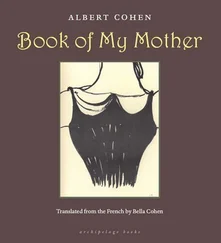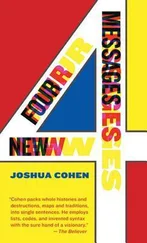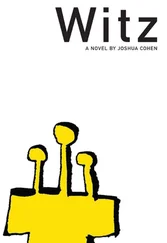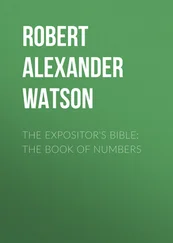Contraction from expansion, expansion from contraction: It was Cohen’s ultimate conclusion that human language had to be computerized — for each user individually. It occurred to him that his language’s proportionality should not be between the sum of its characters and the relative length/shortness of its aggregates, but rather between his parents’ interest in him and his own interest in privacy.
This led him to develop the following resolutions: 1.) His language had to be written, not spoken, because the intimate intricacy of his expressions would be lost to time (the time required by human processing), and 2.) It had to engage that processing in a way that convinced his parents he wasn’t frustrating their ability to comprehend, or respond — instead he was encouraging their interpretation (what his mother called “active communication”).
What Cohen decided he needed was an alphabet of a single letter — something familiar, something recognizable[— a grapheme for the wall of his puerile silicon cave]. The letter he needed had to have a shape that allowed for representational or symbolic variance — many points, many limbs.
After auditioning and discarding the Hebrew letters Shin, Mem, and Ayin (  ), Cohen settled on the
), Cohen settled on the  . [The fourstroked digraphed double
. [The fourstroked digraphed double  , which evolved from the
, which evolved from the  —the dubya, the last ligature remaining in this language.]
—the dubya, the last ligature remaining in this language.]
A normal  , as it would be read in this language, would indicate Cohen himself, in the nosistic or firstperson plural [a note: Cohen always speaks plurally — at what point to mention that?], but rotated 90° to
, as it would be read in this language, would indicate Cohen himself, in the nosistic or firstperson plural [a note: Cohen always speaks plurally — at what point to mention that?], but rotated 90° to  , it would indicate Cohen’s relationship with his father, rotated another 90° to
, it would indicate Cohen’s relationship with his father, rotated another 90° to  , it would indicate Cohen’s relationship with his mother, and rotated yet another 90° to
, it would indicate Cohen’s relationship with his mother, and rotated yet another 90° to  , it would indicate Cohen’s relationship to the both of them[, and to everyone and everything else?]. All pages of this writing had, at their fundament, a variationally turned
, it would indicate Cohen’s relationship to the both of them[, and to everyone and everything else?]. All pages of this writing had, at their fundament, a variationally turned  ,
,  ,
,  , or
, or  —all expressions founded on the kinship of possession. But, notably, each glyph also served as a chronometer, a timeline of a pastless futureless single day, with each of the four prongs divided into six hours, for a total of 24:
—all expressions founded on the kinship of possession. But, notably, each glyph also served as a chronometer, a timeline of a pastless futureless single day, with each of the four prongs divided into six hours, for a total of 24:
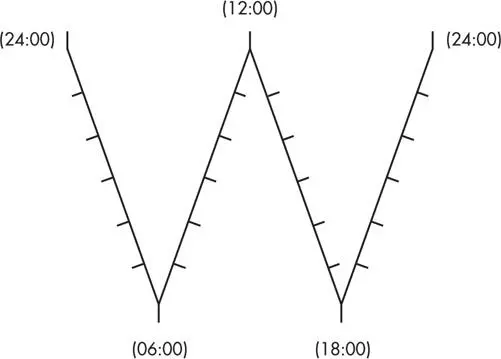
Primary rotations of the  had secondary modifications:
had secondary modifications:  indicating the happy/sad continuum,
indicating the happy/sad continuum,  the sleepiness/wakefulness continuum,
the sleepiness/wakefulness continuum,  hunger/thirst, and
hunger/thirst, and  health/infirmity, with the intensity of whichever condition being expressed by the location of the primary’s junction with the secondary:
health/infirmity, with the intensity of whichever condition being expressed by the location of the primary’s junction with the secondary:  indicating very happy,
indicating very happy,  moderately happy,
moderately happy,  signifying apathy or a median mood,
signifying apathy or a median mood,  indicating moderately sad,
indicating moderately sad,  very sad, and the same scaling applying to the rest:
very sad, and the same scaling applying to the rest:  very sated with food/drink,
very sated with food/drink,  moderately sated with food/drink,
moderately sated with food/drink,  again the baseline,
again the baseline,  moderately hungry/thirsty,
moderately hungry/thirsty,  very hungry/thirsty.
very hungry/thirsty.
At the refined culmen of his language’s development Cohen was operating at 28 fully rotationary levels of physical, mental, and even psychological elaboration [NO NEED TO ELABORATE], supplemented with a variety of auxiliary markers providing spatial context to the foundationally temporal and intensitive: a solid circle indicating school, an open circle, home [NO NEED BUT REPRODUCE AND ANNOTATE AN EXAMPLE].
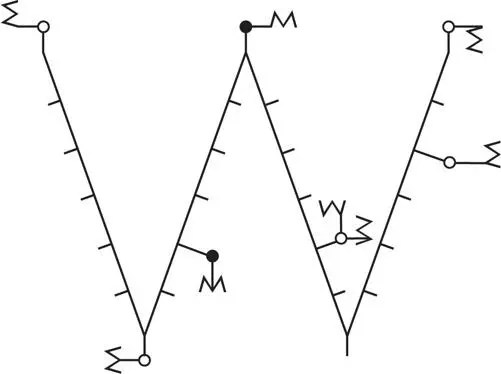
Above would be a typical day, translating to: Cohen [  ] at 24:00 [timemark] at home [open circle] was hyperawake [junction marking the
] at 24:00 [timemark] at home [open circle] was hyperawake [junction marking the  , or secondary sleepiness/wakefulness continuum, at its alert extremity], at 06:00 was tossing between waking and sleeping [
, or secondary sleepiness/wakefulness continuum, at its alert extremity], at 06:00 was tossing between waking and sleeping [  marked at midpoint], at 08:00 found himself at school [solid circle] and indifferent to alimentation [
marked at midpoint], at 08:00 found himself at school [solid circle] and indifferent to alimentation [  at midpoint], though at noon had forced himself or been forced to eat/drink until he was full [
at midpoint], though at noon had forced himself or been forced to eat/drink until he was full [  at its satiated extremity implying an intervening lunch], by 16:00 was back home again and feeling moderately unwell [
at its satiated extremity implying an intervening lunch], by 16:00 was back home again and feeling moderately unwell [  , junction at third apex] and moderately depressed about it [
, junction at third apex] and moderately depressed about it [  , also at third apex], by 22:00 was 25 %/1 prong more awake than the median or 25 %/1 prong less awake than he’d been last midnight, but by this midnight, he was undisturbably asleep [implying, perhaps, that a homeopathic soporific had been administered to him in the interval — Cohen’s was a language of elision and duction by absence].
, also at third apex], by 22:00 was 25 %/1 prong more awake than the median or 25 %/1 prong less awake than he’d been last midnight, but by this midnight, he was undisturbably asleep [implying, perhaps, that a homeopathic soporific had been administered to him in the interval — Cohen’s was a language of elision and duction by absence].
A single expression, then, might easily fill a page. But if a page of Cohen’s language was laborious for his parents to decode, it was doubly laborious for them to reply to, especially by hand, and as the wordprocessing programs of the period weren’t yet capable of typesetting such convoluted hierarchies, Cohen had to code his own, and he did, producing versions for the IBM PC, Tandy, and the Commodores 64 and Amiga. Upon distributing this unnamed or unnameable free langware to his parents in summer 1985, he gave up the language entirely, and never wrote in it again. [Cohen’s mother never installed her  writer.] [While Cohen’s father installed his
writer.] [While Cohen’s father installed his  writer, he found his son had failed to equip it with the marks expressing approval (‘-), and disapproval (-’).]
writer, he found his son had failed to equip it with the marks expressing approval (‘-), and disapproval (-’).]
Читать дальше
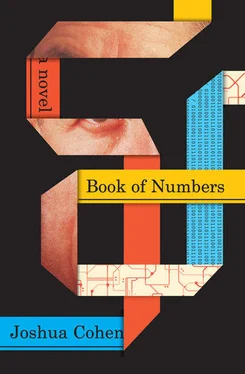
 ), Cohen settled on the
), Cohen settled on the  . [The fourstroked digraphed double
. [The fourstroked digraphed double  , which evolved from the
, which evolved from the  —the dubya, the last ligature remaining in this language.]
—the dubya, the last ligature remaining in this language.] , it would indicate Cohen’s relationship with his father, rotated another 90° to
, it would indicate Cohen’s relationship with his father, rotated another 90° to  , it would indicate Cohen’s relationship with his mother, and rotated yet another 90° to
, it would indicate Cohen’s relationship with his mother, and rotated yet another 90° to  , it would indicate Cohen’s relationship to the both of them[, and to everyone and everything else?]. All pages of this writing had, at their fundament, a variationally turned
, it would indicate Cohen’s relationship to the both of them[, and to everyone and everything else?]. All pages of this writing had, at their fundament, a variationally turned 
 indicating the happy/sad continuum,
indicating the happy/sad continuum,  the sleepiness/wakefulness continuum,
the sleepiness/wakefulness continuum,  hunger/thirst, and
hunger/thirst, and  health/infirmity, with the intensity of whichever condition being expressed by the location of the primary’s junction with the secondary:
health/infirmity, with the intensity of whichever condition being expressed by the location of the primary’s junction with the secondary:  indicating very happy,
indicating very happy,  moderately happy,
moderately happy,  indicating moderately sad,
indicating moderately sad,  very sad, and the same scaling applying to the rest:
very sad, and the same scaling applying to the rest:  very sated with food/drink,
very sated with food/drink,  moderately sated with food/drink,
moderately sated with food/drink,  moderately hungry/thirsty,
moderately hungry/thirsty,  very hungry/thirsty.
very hungry/thirsty.
